Exquisite and delightful Mooncakes with Lotus Seed Paste and Salted Egg Yolks, perfect for celebrating the Lunar New Year and Mid-Autumn Festival! Full and comprehensive recipe to make mooncakes and their fillings from scratch with step-by-step photos.
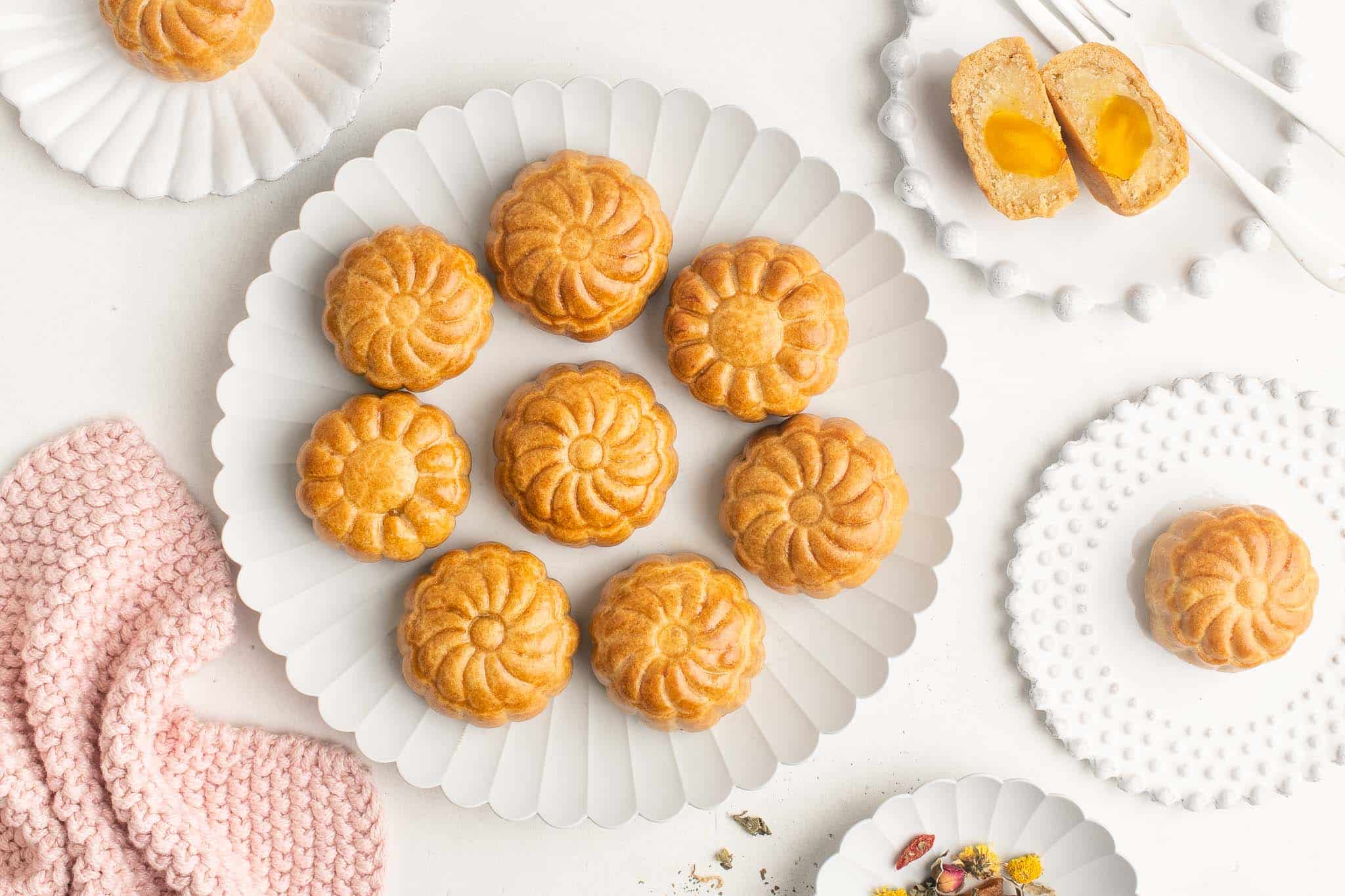
Mid-Autumn Festival
The Mid-Autumn Festival, also known as the Moon Festival, Mooncake Festival or the Harvest Festival, is celebrated in many countries in south-east Asia. The festival is celebrated in different ways – and for different reasons – in different countries, but what is familiar to each festival is the gifting of mooncakes to symbolise family, love and celebration.
In Asian culture, the gifting of mooncakes is similar to sending a Christmas card. Growing up, my mother used to order fresh mooncakes from the local Chinese bakery, and she would gift them to all of our friends, families and neighbours. In return, we used to receive a lot of mooncakes too, and I have fond memories of cutting a small piece from each mooncake to sample.
Traditionally, a mooncake is cut into the same number of pieces as there are family members. Hence, that is why the shops typically sell larger-sized mooncakes. However, my mother used to ignore this rule; she had 11 brothers and sisters when she was growing up and no mooncake was ever large enough for her family!
What are Mooncakes?
Mooncakes vary from country to country. I grew up eating the Cantonese-style mooncakes which are similar to those pictured here: a thick golden pastry wrapped around a sweet bean filling with a salted egg yolk in the centre.
The egg yolk is meant to represent the moon, and the traditional patterns on top of the mooncakes typically have Chinese characters with wishes of good health and prosperity.
Other mooncakes I grew up eating had a flaky pastry, either with the same bean filling, or with a dense filling of chopped nuts (I wasn’t a fan of the latter).
The options for fillings are endless, and there are many “modern” fillings floating around these days, e.g. my Chocolate Fudge Mooncakes, which might appeal more to those not familiar with Asian flavours and textures.
But maybe it is age-related, or that I am simply becoming more nostalgic as I get older, but I feel it is important to keep old traditions alive. My kids are not big fans of Asian desserts, and I’m not sure I was a fan myself when I was their age. But I now crave many Asian cakes and desserts from my childhood, and I hope that my kids might change their minds one day too.
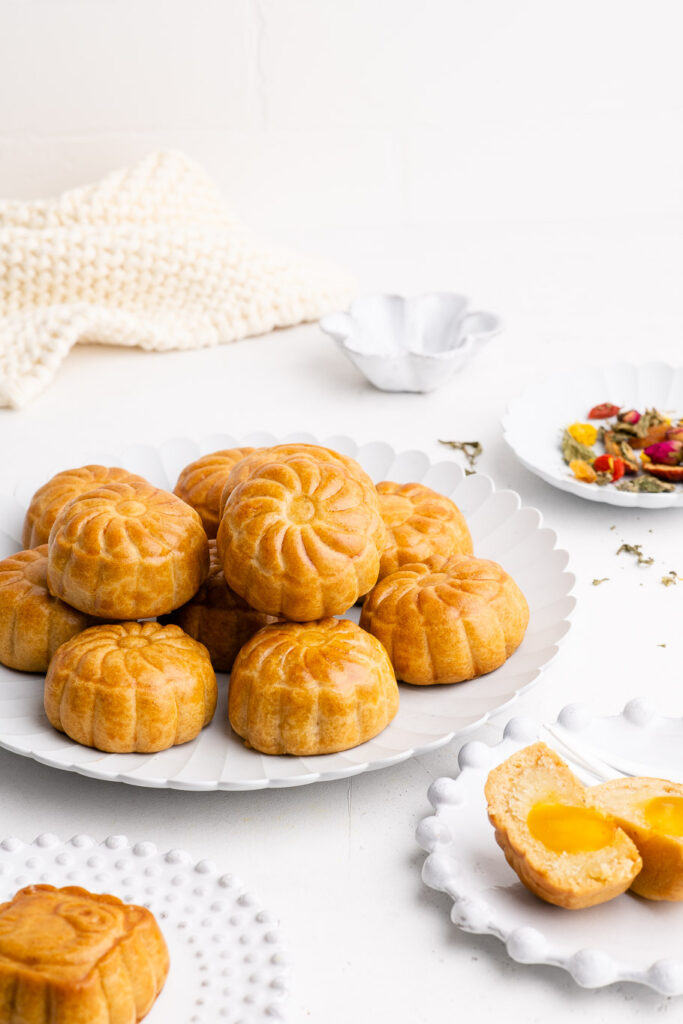
Homemade Mooncakes
Why would anyone make mooncakes at home when you can buy beautifully ready-made ones in the shops?
For me, I moved to Switzerland some 16 years ago. Whilst I am undoubtedly spoilt by the delights of French, Italian and German breads and pastries on offer here, after a few years, I started to miss the many Asian cakes and pastries of my childhood.
In the last 10 years or more, I have been steadily teaching myself to make many Asian baked goods at home. My Chinese Coconut Buns and Hot Dog Flower Buns are a hit with my kids, and I’m hoping they will feel the same way soon about mooncakes.
In recent years, I have seen mooncakes sold at our local Asian grocer, but the variety is very limited, they are very expensive and – to be very honest – not very appetising. They are typically long-haul imported and made god-knows-when, and the neither the filling nor the crust have the taste and smell that I remember as a child.
No doubt, the variety of mooncakes on offer in Chinatown bakeries in Australia are probably on par with those sold in Hong Kong and China, but the random selection I have seen here in Switzerland have been fairly grim.
This is why I started making mooncakes at home – I want my kids to also be familiar with these cakes and their tradition as they grow older. And lucky them … I think homemade mooncakes are much tastier than the shop-bought ones! You can adapt the filling to suit your tastes, and I think homemade fillings taste more fresh and wholesome.
Mooncake Flavours
When making mooncakes, I like to make a variety of fillings, just so there is something for everyone. I always make mooncakes with a Lotus Seed Paste filling, a red bean filling, and something fun like a chocolate fudge filling.
If you choose to use different fillings, I recommend using the same mould for a particular filling, so that you can easily identify them later. For example, I use square moulds for Lotus Seed Paste, round moulds for red bean paste, and the cartoon/kids moulds for any “Western” filling.
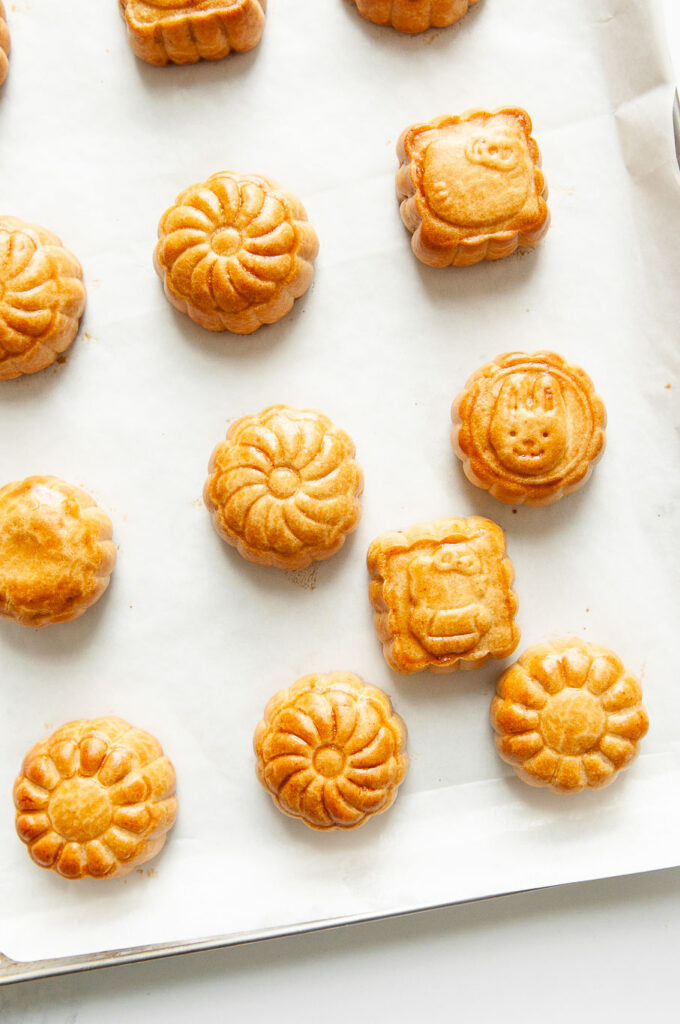
Mooncake Moulds
Pressing the mooncakes into different fancy shapes is undoubtedly the fun part of this recipe!
The mooncake moulds I use for this recipe are cheap and cheerful sets which are readily available on Amazon.
I recommend buying a set with multiple moulds so that you have a variety of patterns to use, and also a combination of square and round moulds.
If you are trying to introduce young children to mooncakes (or any Asian cake, for that matter), it helps to have fun, cartoon shapes on hand to entice them. Although, I am rather impartial to the Hello Kitty moulds for myself!
The mooncake moulds come in a few sizes – 50 g for small mooncakes (generally a good portion for 1 person), or 100 g for large mooncakes intended for sharing.
You can also buy mooncake moulds in other sizes, but you will need a good maths background to calculate the ratio of dough to filling 🙂
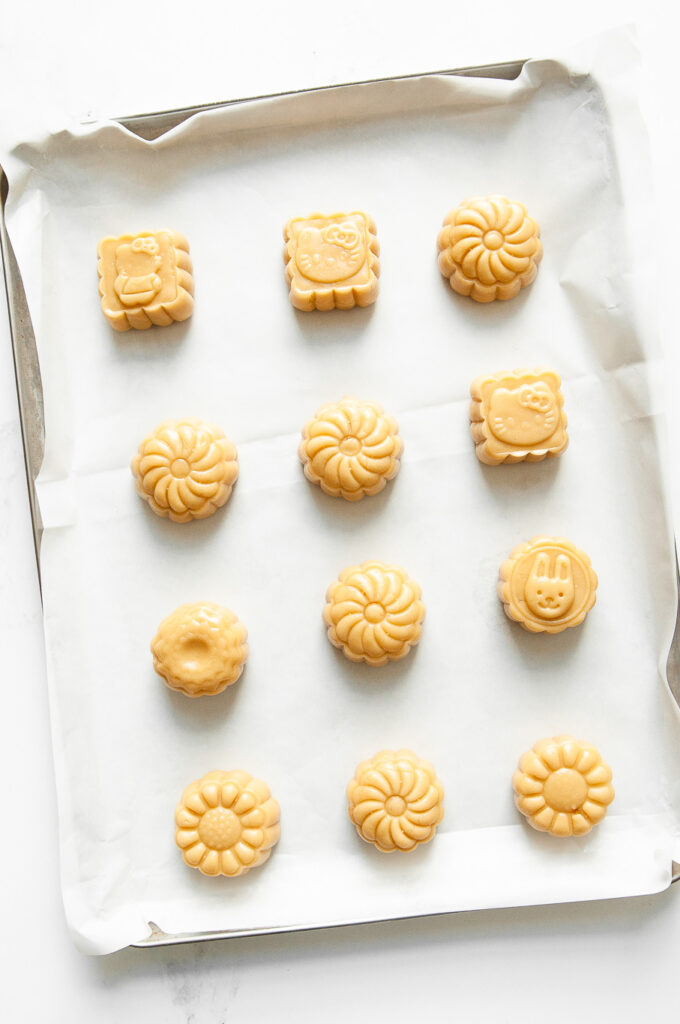
Mooncake Recipe
Mooncakes comprise of several components, namely:
- Making or buying the salted egg yolks (if using)
- Making or buying the filling
- Making or buying the lye water (if this is not available where you live)
- Making the dough
None of these steps are particularly difficult, but they each take time. And because I live in Switzerland where many Asian ingredients are not available, I naturally have no choice but to make each component from scratch!
So my recipe below is a fairly detailed recipe where you can make every component of the mooncakes from scratch at home.
However, if you are able to easily buy salted egg yolks, lotus seed paste and lye water, then all you have to make is the dough which is pretty quick and easy in itself.
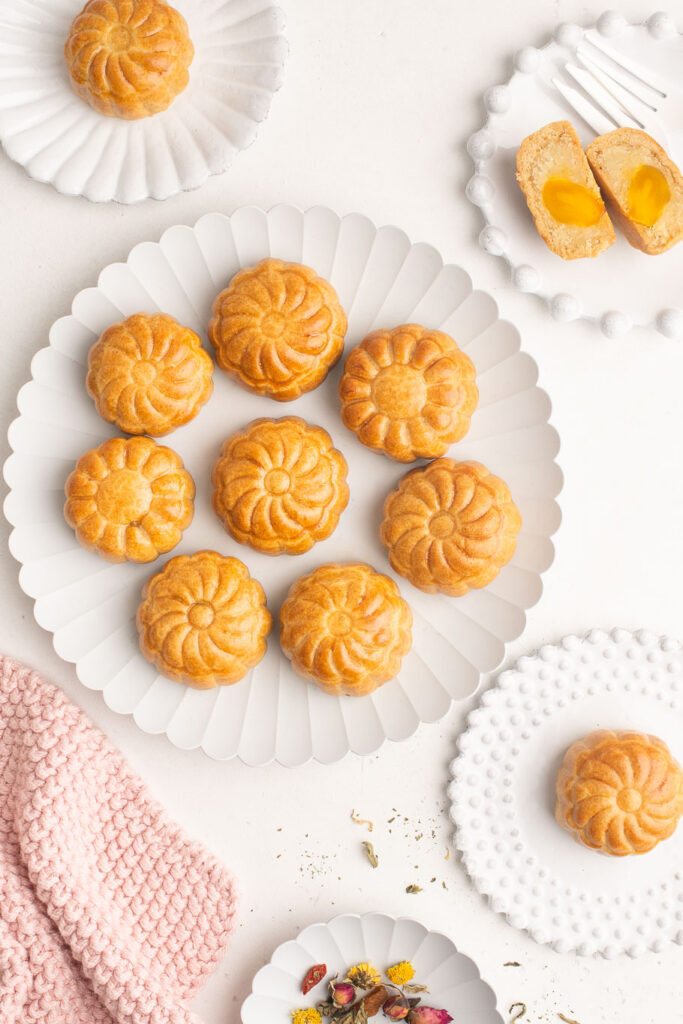
How to Make Mooncakes
How to Make Salted Egg Yolks
You can find ready-made salted egg yolks in some Asian grocery stores, either in the fridge or freezer section. To be honest, they look rather spooky to me!
But making your own Salted Egg Yolks is super easy – you just need good-quality eggs, lots of salt, and a bit of time up your sleeves. It is best to start at least the day before you plan to make the mooncakes.
To make your own Salted Egg Yolks, please see my recipe for Salted Egg Yolks with step-by-step photos.
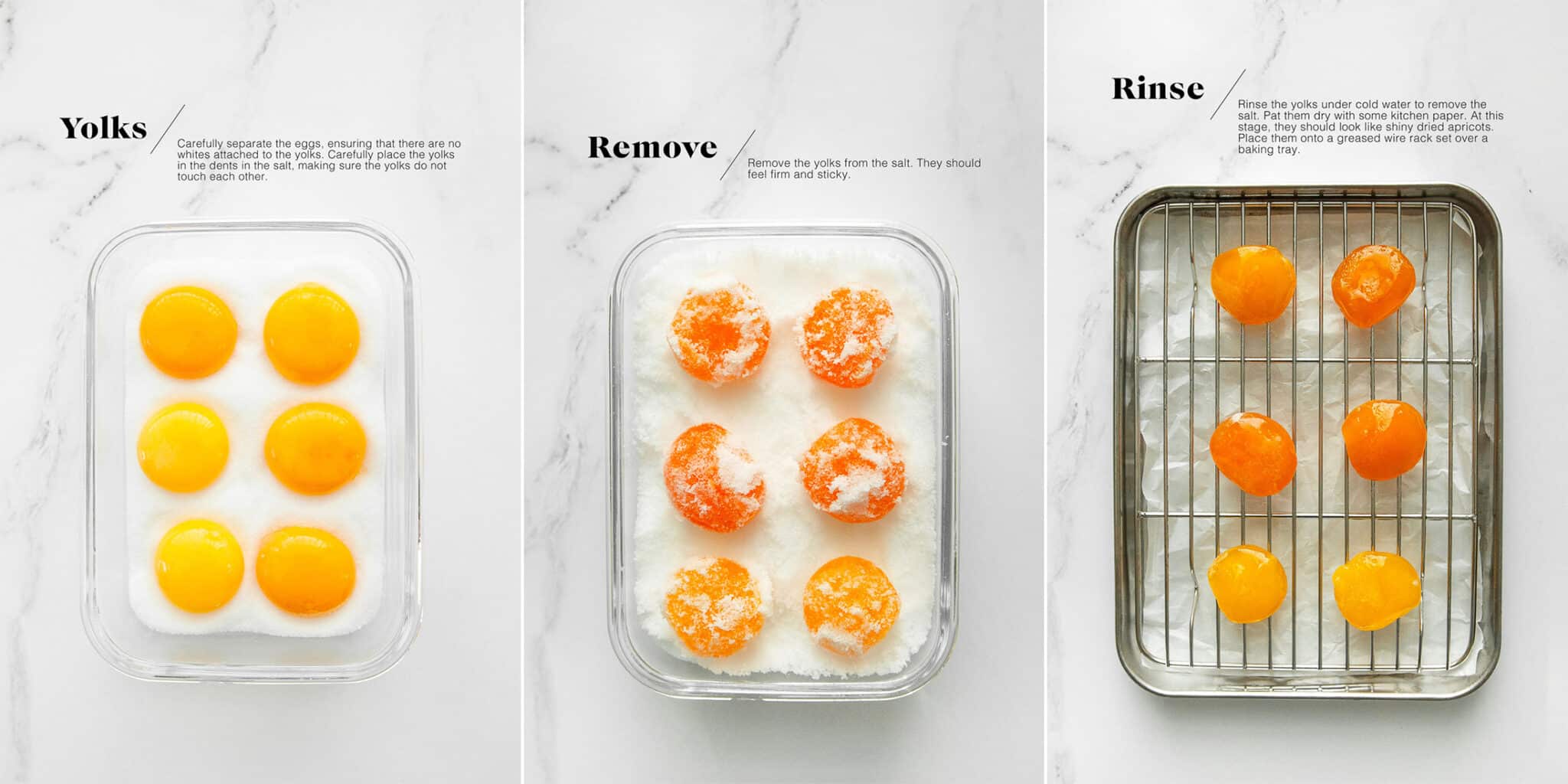
How to Make Lotus Seed Paste
It is possible to buy ready-made lotus seed paste in some Asian grocery stores, but making your own means that it is fresher and with no preservatives added, plus you can control the sweetness of the paste.
To make your own Lotus Seed Paste, please see my recipe for Lotus Seed Paste with step-by-step photos.
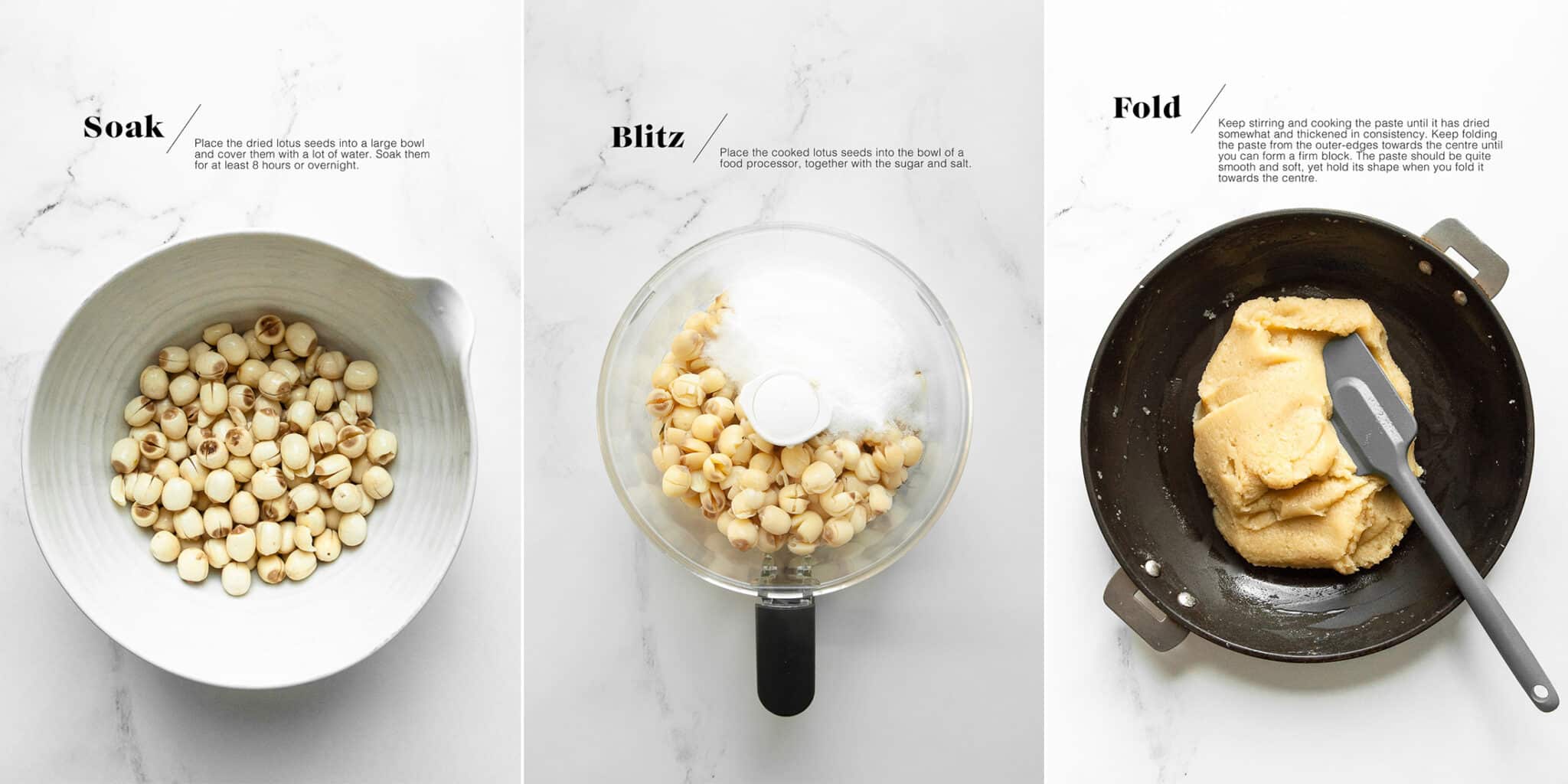
How to Make Lye Water
Lye water is an alkaline water used in some recipes to help with texture or colour. For example, lye water gives pretzels their signature dark brown colour. For mooncakes, a small amount of lye water is used to give the dough a deep, golden colour.
Lye water is readily available in Asian grocery stores in some countries, but not in others. Due to its potency and irritant factor, lye water is even banned in some countries.
If you are unable to buy lye water, please see my recipe on how to make Lye Water with step-by-step photos.

How to Make Mooncake Dough
Please see full recipe instructions in the recipe card below.
This dough is fairly interesting in that it uses golden syrup for both moisture and sweetness. I don’t think you can substitute the golden syrup for another type of syrup, nor is it worthwhile if you want to create a mooncake which is both authentic in taste and texture.
I use Lyle’s Golden Syrup, which is commonly used in British and Australian baking recipes.
When making the mooncake dough, you want a mixture which is fairly soft and pliable. If the mixture looks too dry and crumbly, add a dash of water to try and bring the dough together. Otherwise, a dry dough will be difficult to roll out later to stretch and cover the filling.
When you roll out the dough, it should feel both sticky and oily.
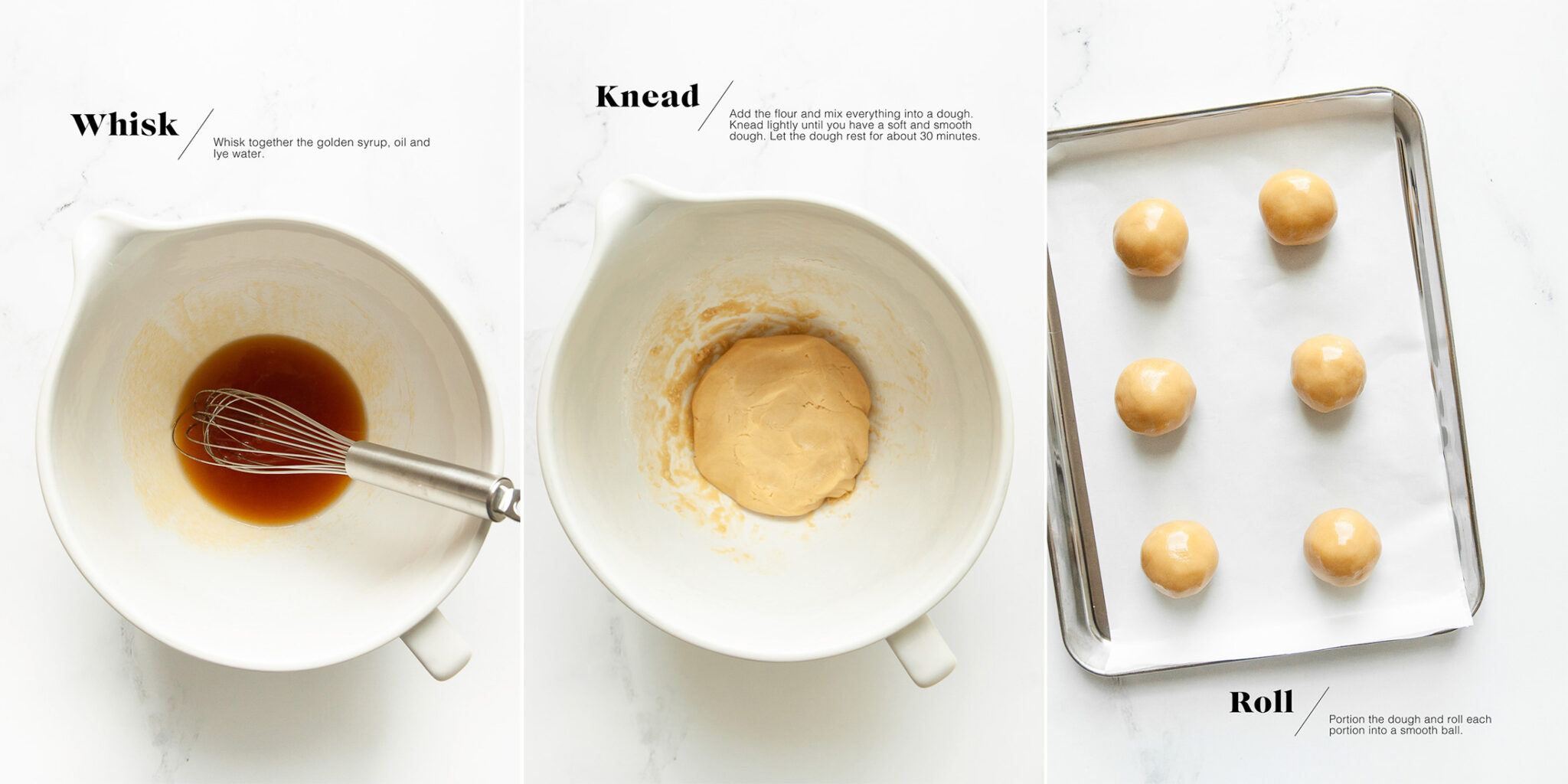
How to Shape the Mooncakes
Please see full recipe instructions in the recipe card below.
Mooncake moulds generally come in two main sizes:
- 50 g moulds – the filling should weigh 30 g, and the dough should weigh 20 g
- 100 g moulds – the filling should weigh 60 g, and the dough should weigh 40 g
You can play around with the ratio of filling to dough, but the total weight should be close to the size of the mould, otherwise the cake will not fit into the mould.
Depending on the consistency of your dough, you may need to dust your mould with some flour to prevent the dough from sticking.
It may take you a few attempts to know how much pressure to apply and when to release the mould, but you should get the hang of it pretty quickly.
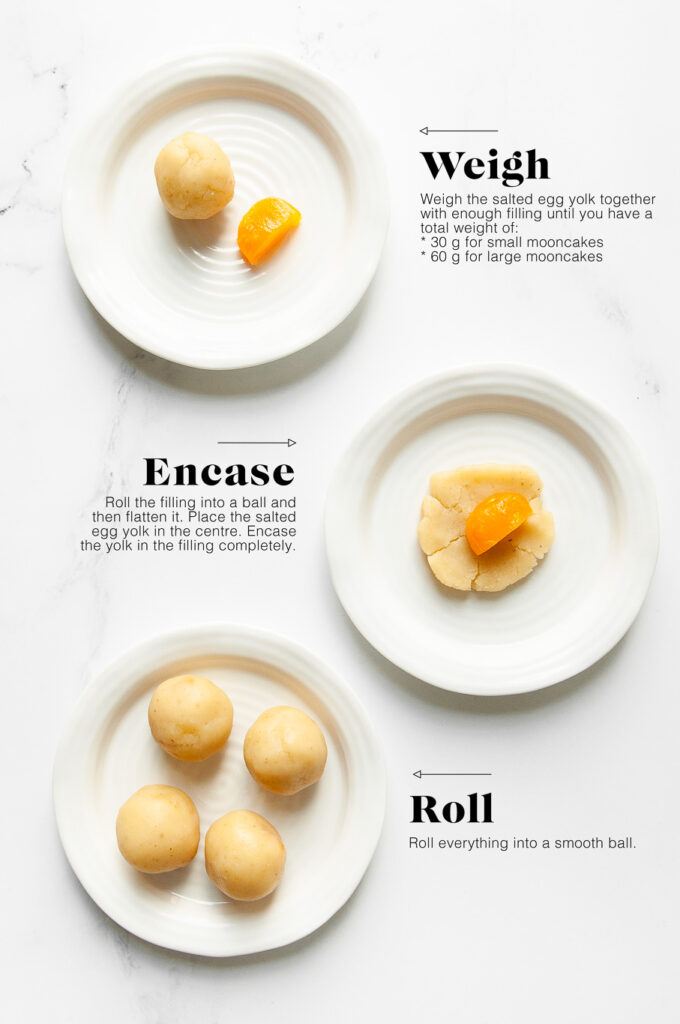
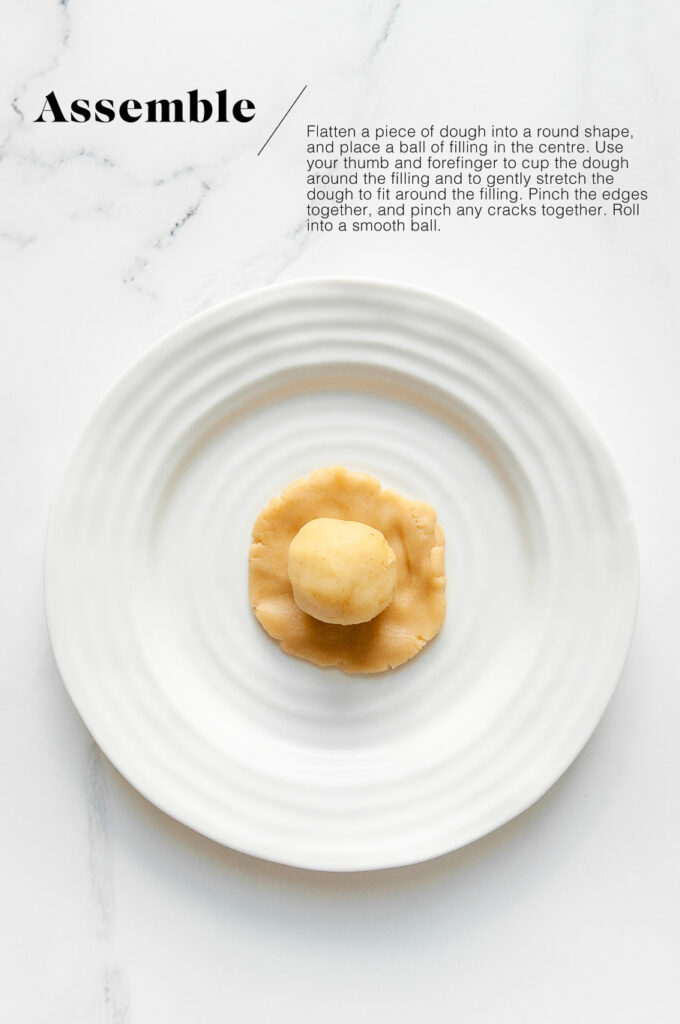
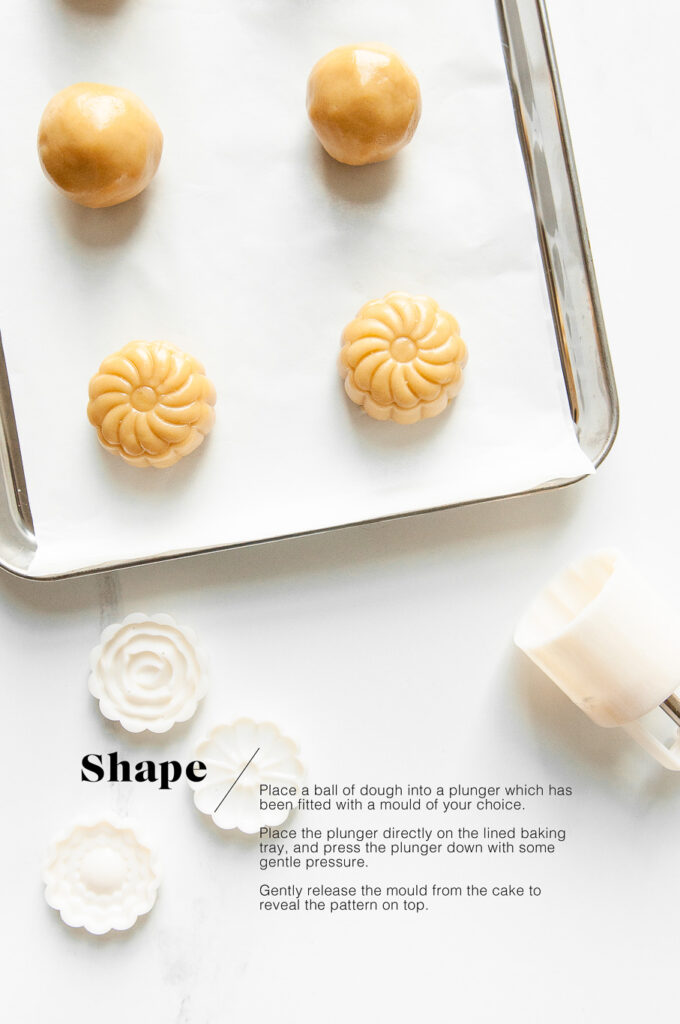
How to Bake the Mooncakes
Please see full instructions in the recipe card below.
Mooncakes need to be baked twice. The first bake is mostly to set the pattern before applying any egg wash. Otherwise, applying the egg wash first might prevent the patterns from staying in place.
After the first bake, you need to let the cakes cool slightly before applying the egg wash. If you apply the egg wash too soon, the egg might coagulate on the cakes and leave spots on the surface.
The egg wash should be brushed only very lightly on the cakes – you want just enough to moisten the dough and to help the cakes brown evenly. I recommend using a pastry brush with fine (natural) bristles which is better at applying the egg wash over the intricate patterns; a silicone brush generally picks up too much egg wash.
The second bake is to fully cook the mooncakes until they are golden brown all over.
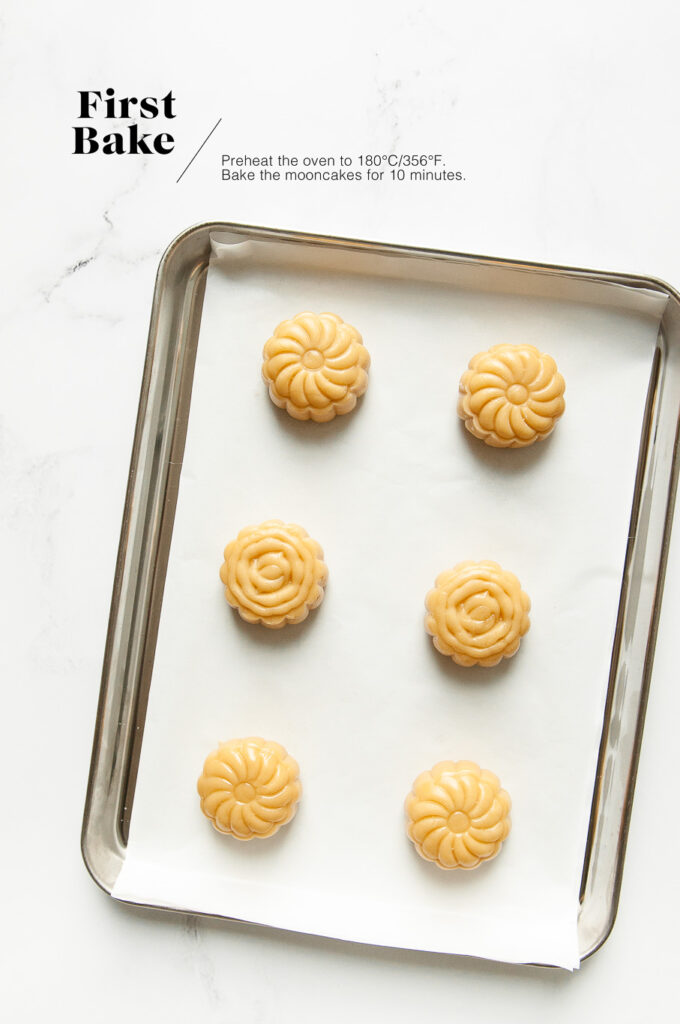
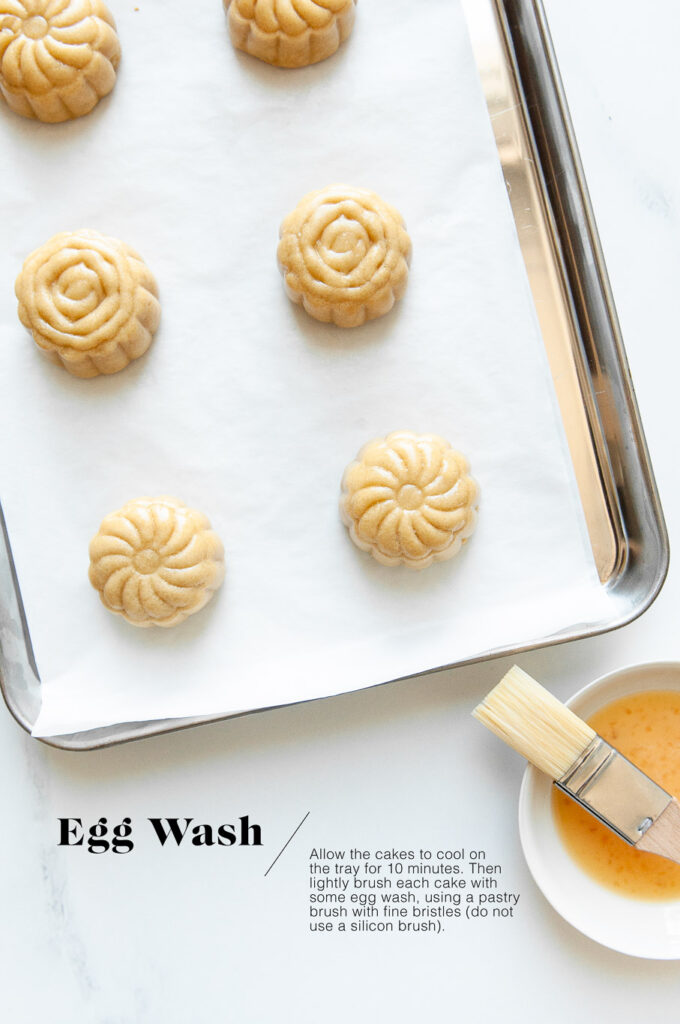

Tips for Making Mooncakes
Making mooncakes is an art form, and this is a recipe which requires a lot of patience and a bit of practice. It took me several attempts before I got the hang of it and understood how the texture and consistency of both the dough and filling should be.
My tips for making mooncakes are:
- Start at least the day before. None of the components of mooncakes are particularly difficult, but they all take a bit of time. Starting everything the day before will make you feel less stressed and rushed when it comes to making the actual cakes.
- Use a digital kitchen scale. Baking is culinary science, and science requires precision. When it comes to making mooncakes and ensuring that each ball of filling and dough is exactly the right size so that it can fit into the moulds, a digital kitchen scale will make life much easier. It will also help to ensure that your dough is made with the right ratio of liquid to flour.
- Experiment with different mooncake moulds. Some moulds look very beautiful but they don’t keep their defined lines once baked. I have a few fun moulds for the kids, including some Hello Kitty shapes, which I find to be too detailed to keep their form during baking. This could be due to a variety of reasons, but don’t be too disappointed if the cakes end up looking like little smooth buns – they will still taste great!
- Make a variety of fillings. If you have time, make a variety of fillings and use the same mould for each type filling, so that you know what is inside. Not everyone likes salted egg yolks (especially kids), so I generally only make half a batch with salted egg yolks inside. Lotus seed paste is my favourite filling, but I also love red bean paste and chestnut paste. There are also many “modern” fillings that you can try, such as green tea paste, chocolate brownie filling … I will try to post my recipes for those fillings here soon!
- Use fun moulds for kids. Indulge the kids and use fun cartoon or animal-shaped moulds to entice them to try the mooncakes. Big kids (aka adults!) love the cute cartoon moulds too!
- Make a large batch. Given the time commitment required for making mooncakes, you may as well make 1-2 batches – they make great gifts for friends and family!
- Practice makes perfect. Like with most things in life, once you have made mooncakes once or twice, the process becomes less daunting. I find making mooncakes to be a bit like making specially stamped cookies.
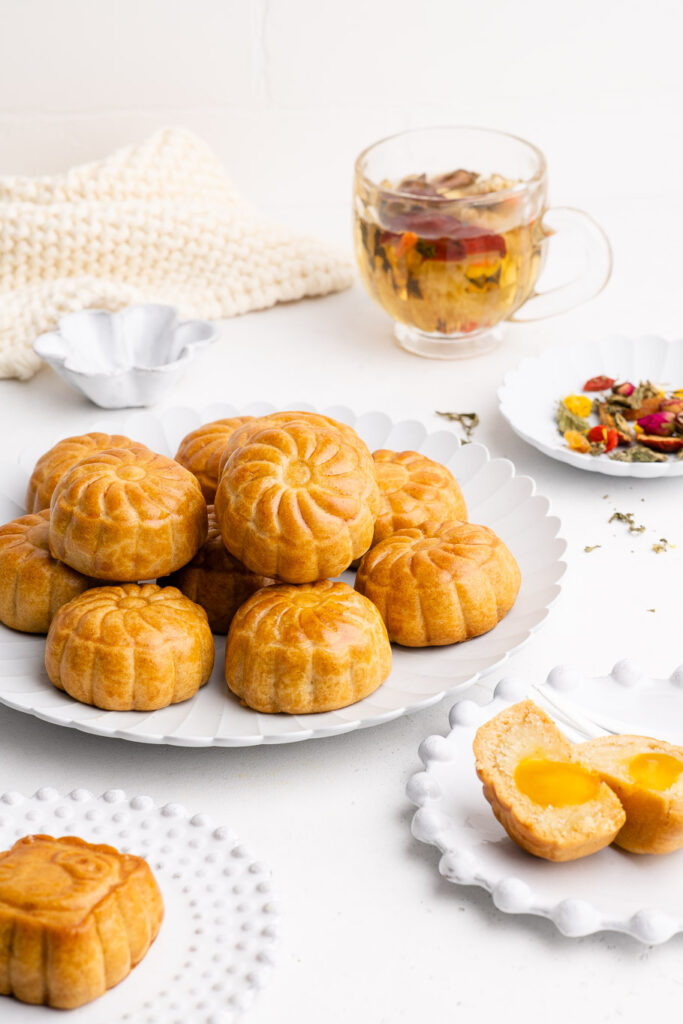
More Asian Cake Recipes
PrintMooncakes with Lotus Seed Paste and Salted Egg Yolks

- Prep Time: 1 hour
- Cook Time: 30 mins
- Total Time: 1 hour 30 minutes
- Yield: Makes 18-20 small mooncakes
- Category: Cakes
- Method: Oven
- Cuisine: Chinese, Vietnamese
Exquisite and delightful Mooncakes with Lotus Seed Paste and Salted Egg Yolks, perfect for celebrating the Lunar New Year and Mid-Autumn Festival! Full and comprehensive recipe to make mooncakes and their fillings from scratch with step-by-step photos.
Ingredients
- 10 Salted Egg Yolks, ready-made or see recipe for Salted Egg Yolks
- approx 2 cups Lotus Seed Paste, ready-made or see recipe for Lotus Seed Paste
For the Mooncake Dough
- 150 g golden syrup
- 50 g sunflower oil (or another flavourless oil)
- 1/2 teaspoon food-grade lye water
- 225 g (1 1/2 cups) plain flour (all-purpose flour)
For the Egg Wash
- 1 egg
- 1 tablespoon water
Instructions
For the Salted Egg Yolks (see my recipe for Salted Egg Yolks with step-by-step photos)
- This step requires approx. 10 hours or overnight.
- If you are making the Salted Egg Yolks from scratch, start this step at least a day before making the mooncakes.
For the Lotus Seed Paste (see my recipe for Lotus Seed Paste with step-by-step photos)
- This step requires approx. 12 hours or overnight.
- If you are making the Lotus Seed Paste from scratch, start this step at least a day before making the mooncakes.
For the Mooncake Dough (this step requires approx. 45 mins)
- Make the Mooncake Dough on the day you plan to make the mooncakes.
- In a large mixing bowl, whisk together the golden syrup, oil and lye water.
- Add the flour.
- Mix everything together until a dough forms.
- Lightly knead the dough until you have a soft and smooth ball of dough. If the dough is too crumbly and doesn’t come together well, add some water.
- Wrap the dough in some cling film.
- Leave the dough to rest at room temperature for at least 30 minutes.
To Prepare the Mooncake Filling
- For a 50 g mooncake mould, the filling should weigh 30 g (together with the Mooncake Dough of 20 g, the cake will weigh 50 g).
- Use a sharp knife to halve the Salted Egg Yolks.
- Place a plate on a digital kitchen scale. Place a piece of Salted Egg Yolk onto the plate, and add enough Lotus Seed Paste until you have 30 g.
- Roll the Lotus Seed Paste into a ball, flatten it into a round shape, and then fully encase the Salted Egg Yolk. Roll the mixture into a small ball. Repeat with the remaining Salted Egg Yolks and Lotus Seed Paste.
- If you are not using Salted Egg Yolks, simply use 30 g of Lotus Seed Paste for the filling.
- For a 100 g mooncake mould, the filling should weigh 60 g (together with the Mooncake Dough of 40 g, the cake will weigh 100 g). Follow the steps as above, but use a whole Salted Egg Yolk.
To Prepare the Mooncake Dough
- For a 50 g mooncake mould, the Mooncake Dough should weigh 20 g.
- For a 100 g mooncake mould, the Mooncake Dough should weigh 40 g.
- At this stage, the dough should feel slightly oily and sticky.
- Portion the dough as necessary using a digital kitchen scale.
- Roll each piece of dough into a smooth ball.
To Assemble the Mooncakes
- Line a large baking tray with baking paper.
- Flatten a piece of Mooncake Dough into a thin round shape which is just large enough to encase the filling.
- Bring the edges of the dough up around the filling, cupping the mixture between your thumb and forefinger as you do so.
- Gently pinch the dough until it stretches to completely cover the filling.
- Pinch any cracks together, or even add a bit of extra dough to patch up any cracks if necessary.
- Roll the mixture into a smooth ball.
- Place the balls of filled dough onto the lined baking tray.
To Shape the Mooncakes
- Prepare the mooncake moulds by affixing your desired stamp to the plunger.
- It may be wise to lightly dust the moulds with some flour to stop the cakes from sticking to the stamps. But I generally find that the dough does not stick, especially if you are using the plastic mooncake moulds like I have.
- Place one ball into the mould. For square moulds, I recommend gently pushing the ball of dough into a squarish-shape with your fingers before inserting it into the mould.
- Place the plunger directly onto the baking tray, and press the plunger down with some gentle pressure. If you press down too hard, you might flatten the cakes too much.
- Gently release the mould from the cake.
- Repeat with the remaining balls of filled dough.
- The cakes do not spread as they bake, but I would still recommend spacing them apart so that they bake evenly.
To Bake the Mooncakes
- Preheat the oven to 180°C/356°F (without fan).
- Bake the mooncakes for 10 minutes.
- Remove the baking tray from the oven and let the cakes cool for 10 minutes.
- Reduce the oven temperature to 160°F/320°F (without fan).
- Meanwhile, make the Egg Wash by whisking the egg with some water in a small bowl.
- Lightly brush the mooncakes with the Egg Wash, using a pastry brush with fine bristles (a silicon brush picks up too much egg wash for this task). Try to avoid putting too much Egg Wash onto the intricate patterns on the surface. If you have too much Egg Wash on the cakes, use some kitchen paper to blot the cakes.
- Return the baking tray to the oven.
- Continue baking the mooncakes for 10-15 minutes, or until they are golden brown all over.
- Let the mooncakes cool completely on the baking tray, which will allow them to develop a crisp bottom.
To Store the Mooncakes
- Store the mooncakes in an air-tight container at room temperature for up to 1 week.
- The mooncakes are typically served after 1-2 days when the dough has softened slightly and the patterns become more settled and defined. However, I recommend trying at least one while it is still fresh and the dough is somewhat crispy.
- The mooncakes can also be stored in an air-tight container in the fridge. Bring the cakes to room temperature before serving.
Kitchen Notes
 OVEN TEMPERATURES
OVEN TEMPERATURES
All recipes on this website state temperatures for a regular oven (i.e. a conventional oven without fan). If you have a convection oven with a fan, please consult the manufacturer’s handbook on how to adjust the temperature and baking time accordingly.
 CONVERSIONS
CONVERSIONS
To convert from cups to grams, and vice-versa, please see this handy Conversion Chart for Basic Ingredients.
 Print
Print Pin Recipe
Pin Recipe Rate
Rate
Thank you so much for your comprehensive recipe! Your photos were so helpful. This was my first time making mooncakes at home and your recipe was so so helpful. My first attempt was ok … but I think I have the hang of it now.
Hi Anna,
Thanks for your comment! I agree that you need to try the recipe once to get the hang of it, but I’m sure your mooncakes turned out great!
Wow! Great tutorial for making mooncakes! I followed your recipe exactly but I didn’t make the salted egg yolks. I also used store bought lotus paste but I will definitely make my own next time.
Hi Evie,
Thank you! You can totally use store bought lotus paste, but the homemade version will always taste better 😉 Thanks for trying this recipe!
Excellent recipe, thank you! My mooncakes turned out brilliantly. I can’t wait to cut into them soon!
Hi Angela,
Thank you! Hope you will enjoy the mooncakes 🙂
Omg you totally convinced me to make mooncakes from scratch at home. It’s a labor of love but the end results were so worth it. Your step by step photos were very helpful. Thank you!
Hi Jenny,
So glad you enjoyed this recipe 🙂
Great tutorial for making mooncakes. My mother made the lotus paste and I made the rest of the recipe. After making the first mooncake, you sort of get the hang of how to make them. We were so proud of our homemade mooncakes! We will not be buying them ever again 🙂
Never in my life did I ever think I would make my own mooncakes but your photos somehow convinced me. Thank you for your helpful instructions. My mooncakes turned out so beautiful! And they taste out of this world too. I think I prefer them fresh on the same day of baking than a few days later when they have softened.
I can’t wait to make these for the Lunar New Year! Thanks also for your links to the mooncake molds.
Now that Christmas is over, I’m looking forward to the Lunar New Year preparations lol! I just made the lotus paste and can’t wait to make the mooncakes tomorrow for a test run.
Hi, thanks for the recipe. Do you use the egg wash to brush the sides of the mooncake too or just on the top? What would happen if I brush it all over?
Hi Jen,
Yes, you should brush the sides of the mooncakes with egg wash too, so that the mooncakes will have the same colour all over. Hope you will enjoy this recipe!
By far the easiest and best instructions I have found to make mooncakes. Thank you! I made this recipe but without the salted egg yolks. They don’t taste like the ones you get from the shops, but in a good way! I will using this recipe again and again.
Thank you for the detailed instructions! I made the lotus filling and salted egg yolks a few days ago, and I plan to make the mooncakes today. Can’t wait!
Wow, fantastic recipe! I followed your instructions to the T and my mooncakes turned out beautifully. I’m so impressed!
Hi Sue,
So glad you they turned out great 🙂
Thank you for the recipe!
Hi Lenore,
You’re welcome!
I’m obsessed with these mooncakes! I made them last year, and I have already made 2 batches this year. Your recipe is simply 10/10!
Hi Danielle,
Thank you so much for your feedback! 🙂